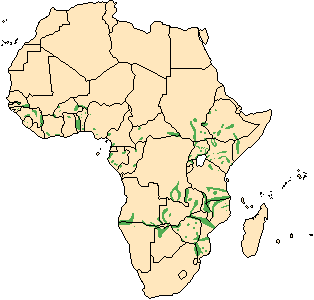![]() Return
to Artiodactyla
Return
to Artiodactyla
Classification
|
 Hippopotamus
amphibius
Hippopotamus
amphibius
River hippopotamus
![]()
Taxonomy
 |
 |
 |
Click on the pictures above for a larger view of the
photographs
|
||
General Characteristics
Body Length: 300-540 cm / 10-15 ft.
Shoulder Height: 130-165 cm / 4.3-5.4 ft.
Tail Length: 35 cm / 14 in.
Weight: 655-3,200 kg / 1,440-7040 lb.The back is a purplish grey-brown, with the undersides pinkish. There are patches of pink on the face, especially around the eyes, ears, and cheeks. The hide is virtually hairless, and is moistened by mucous glands which secrete a reddish liquid. The body is bulky and barrel-like, and is supported by stubby legs. The large, wide head has the eyes, nostrils and ears set on the top, allowing them to remain above water while the hippo is submerged. The mouth is widely split and can be opened extremely wide, exposing the canines, which are large and curved.
Ontogeny and Reproduction
Gestation Period: 8 months.
Young per Birth: 1
Weaning: After 6-8 months.
Sexual Maturity: Females at 4-10 years, males at 7-12 years.
Life span: Up to 50 years, usually 30-40.
Ecology and Behavior
The river hippopotamus spends most of the day wallowing, resting, and swimming in or near water. At night, they emerge from the water to graze. Hippos will graze about 3 kilometers / 1.8 miles from water, although some individuals move further inland. An individual may walk 10 kilometers / 6 miles to seek food on land, spending an average of 5-6 hours on land per night. Despite their bulk, they can run extremely fast. A river hippo's daily consumption is 1-1.5 percent of its body weight, compared to an average of 2.5 percent for most other ungulates. Well at home in the water, their specific gravity allows them to walk along the bottom and makes it difficult for them to truly "swim". When submerged, they can seal off their slit-like nostrils and ears. The shape of their head is much like that of a frog, and allows them to keep their eyes and nostrils above the surface, while keeping the rest of their body submerged. Hippopotamuses usually remain submerged for 3-5 minutes, though they can stay below for up to 30 minutes. Population densities vary, and can be as great as 31 animals per square kilometer. Adult males defend narrow territories which consist of water and the adjacent land. Both sexes are very aggressive - males defending their territory may kill another hippo nearby when courting females, and females join together to protect their offspring. The hippos major weapon is the set of large, sharp lower canines which, in males, may grow to 0.5 m / 1.5 feet long. The main vocalizations are a "wheeze-honk" and a roar.Family group: Groups of 10-150 animals.
Diet: Grasses.
Main Predators: Crocodile, lion, hyena, and leopard prey on young.
Distribution
Rivers and lakes surrounded by grasslands throughout sub-Saharan Africa.

Range Map (Redrawn from Eltringham, 1993)
Conservation Status
The river hippopotamus as a species is common, although H. a. tschadensis is classified as vulnerable by the IUCN (1996).
Remarks
The river hippopotamus was described by Linnaeus in 1758. Despite their placid and clumsy appearance, river hippos can be aggressive towards humans, and there are many reports of small boats being overturned and their occupants being bitten to death. Hippos (or crocodiles, depending on who you talk to) are said to kill more people in Africa than any other animal.
Hippos (Greek) a horse; potamos (Greek) a river. Amphi (Greek) around, on both sides; bios (Greek) living, manner of living: meaning living on both sides i.e., on land and in water.
Literature Cited
Eltringham, S. K. 1993. The Common Hippopotamus (Hippopotamus amphibius). In Pigs, Peccaries and Hippos: Status Survey and Action Plan. Edited by W. L. R. Oliver. Gland, Switzerland: IUCN. pp. 161-171. Available online at http://iucn.org/themes/ssc/sgs/pphsg/Contents.htmKlingel, H. 1990. Hippopotamuses. In Grzimek's Encyclopedia of Mammals. Edited by S. P. Parker. New York: McGraw-Hill. Volume 5, pp.60-79.
Nowak, R. M. [editor]. 1991. Walker's Mammals of the World (Fifth Edition). Baltimore: The Johns Hopkins University Press.
Wilson, D. E., and D. M. Reeder [editors]. 1993. Mammal Species of the World (Second Edition). Washington: Smithsonian Institution Press. Available online at http://nmnhwww.si.edu/msw/
Return to Artiodactyla

![]()
© Brent Huffman, www.ultimateungulate.com |
|
|